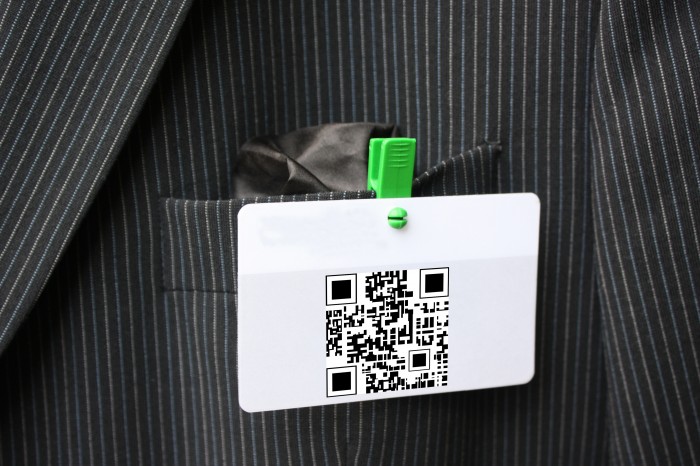 Trade shows can be valuable investments that get your brand in front of hundreds – and sometimes thousands – of prospects. In fact, according to the Content Marketing Institute, 76% of best-in-class B2B marketers rate in-person events as one of the most effective tactics for generating leads. Attending a trade show can build business relationships; if your organization goes the extra mile and becomes an exhibitor, a show can also be an excellent opportunity to position your brand as a thought leader.
Trade shows can be valuable investments that get your brand in front of hundreds – and sometimes thousands – of prospects. In fact, according to the Content Marketing Institute, 76% of best-in-class B2B marketers rate in-person events as one of the most effective tactics for generating leads. Attending a trade show can build business relationships; if your organization goes the extra mile and becomes an exhibitor, a show can also be an excellent opportunity to position your brand as a thought leader.
However, without the right strategy, these events can be a waste of time, money, energy and patience. Trade show success is about more than remembering to bring business cards, keeping a pen in your pocket, and maintaining a pleasant expression. It’s about demonstrating value, showcasing your ability to fulfill your prospects’ needs, and setting the stage for long-term customer relationships.
Here are eight tips to help you get better results from every trade show you attend:
- Have a purpose. When preparing for the event, determine the goals first. Examples of goals include growing relationships with current and prospective customers, marketing a new service, generating a certain number of new leads, or building brand awareness. Simply attending a trade show to hand out business cards and candy isn’t effective unless it’s Halloween and your prospects are trick-or-treaters.
 Most business cards end up in the circular file – the “recycle bin” if it makes you feel better – without ever being used by anyone to make any connection. So if your goal is lead generation, consider this crazy-like-a-fox strategy: don’t hand out your business cards. Instead, focus on collecting the cards of your prospects. Those cards become a nice stack of leads that you and your team can quickly begin to nurture.
Most business cards end up in the circular file – the “recycle bin” if it makes you feel better – without ever being used by anyone to make any connection. So if your goal is lead generation, consider this crazy-like-a-fox strategy: don’t hand out your business cards. Instead, focus on collecting the cards of your prospects. Those cards become a nice stack of leads that you and your team can quickly begin to nurture. - Pick a target. To get the most ROI from a trade show, you have to talk to the right people. As you plan for the event, consider the industry, company size, and specific professional title and role that will help your team fulfill its identified purpose. Then examine lists of attendees who participated in past trade shows to find those who fit the criteria and who are likely to attend the upcoming conference. Reach out to your targets before the trade show begins and invite them to your booth, to coffee or dinner, or to breakout meetings during times when the exhibit hall is closed.
- Prepare your answers. Booth visitors tend to ask the same types of questions. After preparing a list of questions that prospects tend to ask, review the answers with your team to ensure everyone communicates the same message. Practice your talk tracks in advance to make sure you’ve got them down. Most importantly, remember to listen carefully first and tailor your responses, rather than just waiting for the person to stop talking so you launch into your script. A thoughtful, relevant answer that’s a little rough around the edges is worth much more than a polished pitch that doesn’t answer an actual question.
- Give relevant freebies. When you give away swag, it should be useful and appropriately represent your company. It’s also a good idea for it to be different than what the other vendors give away. With trade shows filled with T-shirts, stress balls, lanyards, and drink cozies, something as simple as a branded stylus or cell phone holder may be the trick to driving traffic your way. If you have relevant content, such as white papers, brochures, or eBooks, print out a selection and hand them out to interested parties. If there’s a lot of down time between sessions, you may have the chance to educate and nurture your prospect right away.
- Use active media – your voice. Traditional marketing starts with mailers, phone calls, and social media connections in hopes of getting a face-to-face meeting. At trade shows, you can skip the passive media and immediately get face-time with decision makers. Take advantage of this opportunity to make a personal connection with the targets that your team identified. Sometimes a confident conversation and a firm handshake is all you need to gain a new client or meet a valuable partner.
- Trade leads with other vendors. Not every person that you meet at a trade show is a good match for your company. The same is true for other vendors at the event. When you get a business card from someone who isn’t a target, give it to a fellow vendor who may benefit from it and ask for the same favor in return. In addition to generating more high-value leads, the vendor may become a good client or partner.
- Follow up fast. When you generate a lead, follow up with the individual as soon as possible, if not immediately. When someone is interested in what your company offers, for example, go to a meeting room and have a discussion straight away. If the individual is pressed for time, schedule a follow-up meeting for a day during or immediately following the show. At a minimum, follow up the same day with an email and a social media connection request, and call the person the next day. And remember: even if you’ve acquired leads during the trade show, it doesn’t mean they’re all ready to buy. Put a lead nurturing program into place before the event, so you’re ready to start it up right after the show is over. You need to communicate with your leads while the event is still fresh in their minds, and a series of emails delivering relevant content can help cement the relationship.
 Take advantage of technology. To the extent possible, use technology to gather leads faster. Many trade shows have bar codes on attendee badges, making it easy for vendors to capture their information. If not, use a business card scanner to turn the paper-based data into searchable, actionable information right at the point of capture.
Take advantage of technology. To the extent possible, use technology to gather leads faster. Many trade shows have bar codes on attendee badges, making it easy for vendors to capture their information. If not, use a business card scanner to turn the paper-based data into searchable, actionable information right at the point of capture.
Trade shows don’t have to be about sore feet or putting on exhausting productions. They can have great potential if you choose the right ones, plan strategically, and stand out. So put these strategies into place, and turn every event into an opportunity.
 No matter what types of events you’re planning, the right approach to data management and marketing automation can eliminate potential issues while maximizing your event ROI. Read this guide to get eight important tips for taking an automated, data-driven approach to your events.
No matter what types of events you’re planning, the right approach to data management and marketing automation can eliminate potential issues while maximizing your event ROI. Read this guide to get eight important tips for taking an automated, data-driven approach to your events.
